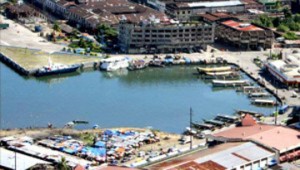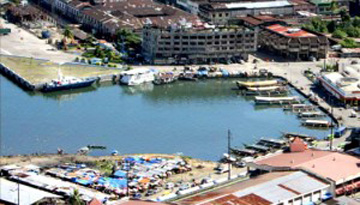 International Container Terminal Services, Inc (ICTSI) will temporarily take over operations of Tacloban port, one of the many structures damaged by super typhoon Haiyan (local name Yolanda) in central Philippines.
International Container Terminal Services, Inc (ICTSI) will temporarily take over operations of Tacloban port, one of the many structures damaged by super typhoon Haiyan (local name Yolanda) in central Philippines.
The company on Saturday said it was deploying to the port various cargo-handling equipment valued at over P200 million as well as a start-up team of engineers, operations managers and staff, and equipment operators from Manila International Container Terminal (MICT), ICTSI’s flagship.
ICTSI head of Asian Region Christian R. Gonzalez said the company will run for free the Tacloban port and continue to do so until government relief operations end and normal transportation network is restored, at which time the group will pull out all its equipment and personnel.
The port operator signed a relief support agreement with the Department of Transportation and Communications (DOTC) and the Philippine Port Authority (PPA) last Saturday.
“We have been closely working round-the-clock with DOTC and PPA to get this project running at the quickest time possible. We have dispatched our equipment, which should arrive in Tacloban by Tuesday (Nov 19). By then, the port will be fully operational,” Gonzalez said.
Among equipment for deployment is a brand-new mobile harbor crane being commissioned in Davao. The crane cannot be positioned in Tacloban because the port there is not deep enough to support heavylift vessels carrying the equipment.
As its donation to the typhoon victims, spreader manufacturer Stinis from Holland added two more back-up spreaders to ensure the smooth and continuous operation.
At the MICT, ICTSI opened its container freight station facilities to the Department of Social Welfare and Development (DSWD). The terminal’s CFS 2 was designated as DSWD’s relief operations center (ROC), where international relief donations entering the Port of Manila are processed. The ROC is manned by ICTSI volunteer employees and DSWD volunteers working 24/7.
Two-stage relief structure
Meanwhile, a system has been drawn up to enable faster transport of relief goods to areas in the Central Philippines devastated by Haiyan.
A two-stage structure proposed by Manila North Harbour Port Inc. (MNHPI) designates the Manila North Harbor as central staging area where relief goods can be consolidated in containers before they are shipped to the ravaged regions.
The proposal was presented to the Department of Transportation and Communications (DOTC) and PPA in a logistics summit on Nov. 16 by MNHPI president Michael Romero.
Romero said fees at the North Harbor and Harbour Centre, a bulk and break bulk terminal, for the transport of relief goods had been waived, as with shipping and trucking fees for Integrated North Harbor Truckers Association (INTHA) members helping in the relief operation.
The PPA earlier said it would either lift or cut port charges for ships ferrying relief goods. The issue was to have been discussed by the agency’s board on Nov. 19, according to PPA assistant for legal and operations David Simon.
Stage One
The proposed structure has two stages.
Stage One is the logistics operations. Relief goods from all sectors will be handled at the central staging area at the North Harbor Pier 2. The plan calls for shipping the goods in containers to Cebu, stripping them, and then shipping onward via barges or smaller vessels to Tacloban, Ormoc and Guiuan. (Tacloban has a shallow draft so it cannot handle big vessels.)
Simon said ports in typhoon-hit areas are open “but their capability (to handle vessels) is in question”. He said Sta. Ana and his team will go to Tacloban to address the situation.
Manila North Harbor will decide which shipping line will transport the relief containers and will collaborate with shipping lines for schedule of trips and routes that will be used.
Stage Two
Stage Two is the distribution system in the Visayas ports. The ports will accept cargoes that will be brought to staging warehouses for delivery via trucks, buses and jeepneys to the affected barangays.
Romero said 200 containers a day can easily be provided to ship relief goods to Cebu and that there will be no problem when it comes to the Manila side. A container can carry 18 tons of goods, and a vessel can carry 300 boxes, he pointed out.
He acknowledged that the problem could be in the area of distribution. There should be proper staging areas in ports and typhoon-hit areas to accommodate cargoes from Manila otherwise there will be bottlenecks, Romero said.
“What we can provide are trucks that can carry container vans,” said Teodorico Gervacio, INHTA president. He said foreign shipping lines are volunteering their trailers to carry containers, which can be prepositioned to load relief goods. These trucks can also head to the ships and bypass the staging area for quicker transport.
A structure for airlines has also been worked out as part of the relief system. The first stage will be the same as for the maritime structure, but goods will be airlifted to Tacloban, Capiz and Cebu. From the airports, bus, tucks, and jeepneys will carry the goods to the ports, which will then be shipped to the affected areas.
The logistics summit was attended by various shipping lines-Philippine Span Asia Carrier Corp, Solid Shipping, Oceanic Container Lines, Gothong Southern Shipping Lines, 2Go Shipping, F2 Logistics, Philippine Red Cross, ABS-CBN Foundation and Kapatid Foundation
Connecting the dots
DOTC Undersecretary for Operations Eduardo Oban Jr. said he was satisfied with the proposed structure.
“It’s a very good recommendation,” Oban noted, adding that the summit had “connected the dots.”
He said the proposed structure was accepted by all parties but that there had been previous arrangements with truckers and shippers for transporting the relief goods.
“We’re just completing these (arrangements) before we shift to the proposed structure,” he told PortCalls.
He said 140,000 packs of relief goods are needed to be shipped to typhoon-hit areas daily. The Department of Social Welfare and Development (DSWD) will provide the locations where the goods would be taken.
Oban assured Gervacio that trucks used to transport relief are exempt from the truck ban as long as they display the sign “DSWD relief operation. Do not delay”.
Metro Manila Development Authority general manager Corazon Jimenez in a separate statement said the trucks are exempt until end of the month.
She said the exemption covers trucks and other heavy vehicles being used to transport relief goods to three relief repacking centers — Ninoy Aquino Stadium, DSWD relief station located on NAIA Road, Pasay City, and Air 21 Warehouse on Old MIA Road, Barangay (village) Vitalez, Paranaque City. ––Roumina M. Pablo





